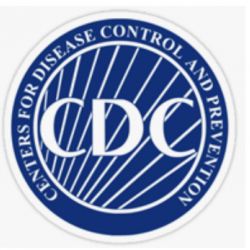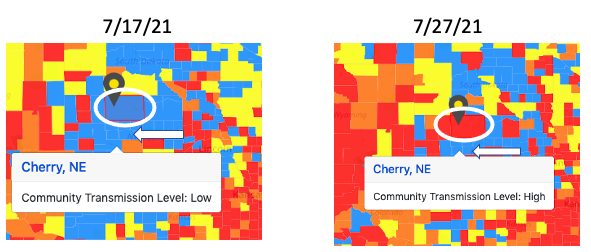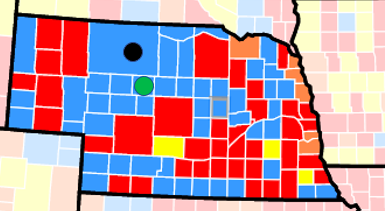New CDC recommendations say that the use of masks indoors should be governed by the level of COVID transmission in a particular area. But the agency's plan is unworkable. Here's why.

On July 27th the CDC issued updated guidelines for the re-masking of America for people who have been vaccinated. No matter what your personal feelings are regarding donning a mask again I think it's safe to say that the agency's plan, which is based upon "areas of substantial or high transmission" is so flawed as to render the entire plan unworkable. There are four changes for "fully vaccinated people given new evidence on the B.1.617.2 (Delta) variant currently circulating in the United States". Let's focus on the first.
"Added a recommendation for fully vaccinated people to wear a mask in public indoor settings in areas of substantial or high transmission."
How Will This Work?
The US map of levels of transmission (below) covering the period between July 17-27 (1) is shown below.

Level of transmission, July 17-27. Blue = Low, Yellow = Moderate, Orange = Substantial, Red = High. Source: CDC COVID-19 Integrated County View.
It is immediately obvious that the US as a whole became substantially more infectious during this 10-day period. But when small areas of the country are examined and found to have a large disparity of numbers – even in adjacent counties – the quality of the data must also be questioned. If recommendations are based on faulty reporting and/or data collection the shortcomings in the CDC recommendations become apparent.
For example, Cherry County in Northern Nebraska, which is one of 93 counties in the state and 3,006 in the US, clearly demonstrates the nearly impossible logistics of using local transmission levels as a guide to indoor mask use.

It Won't Work
The map on the left shows transmission levels in and around Cherry County (white oval), which is one of 93 counties in Nebraska, during a 10-day period from mid-to-late July. Note that on July 17th Cherry County was blue - the lowest level of infectivity, but by July 27th it was red - the highest. Not only is this a big change in a short period of time, but on some unknown date during this time blue became yellow, yellow became orange, and orange became red. Does the CDC really expect the people in Cherry County to know that it was OK to go to the supermarket without a mask on July 20th but not on July 22nd? Of course, not.
The close-up view highlights another fatal flaw in the plan - geography. While Cherry County went flying through all the colors Thomas County in 10-days, its neighbor to the south (white arrow), remained blue. What are people supposed to do when they could literally walk across the street and go from low to high and then back the other way?
What Will Really Happen

The figure above shows Nebraska on July 21st. Cherry County (black dot) and Thomas County (green dot) are still blue - low transmission. Given the rapidity of the change in transmission status and the proximity of high and low counties I can only foresee two possibilities: 1) all of Nebraska will be treated as if it is red; 2) people will simply ignore infection status entirely. This will essentially leave us where we were in pre-vaccine days where governors of entire states either went along with CDC mask recommendations or did not.
The New CDC Policy is a Cop Out
By formulating a plan that is unworkable CDC has put the burden of decision back on the states. "Pro-masking" states will have to treat the entire state as if it were red while "anti-masking" states will flout the advice. So, we can look forward to more of the charming political squabbles we've become accustomed to.
But It May Be Worse This Time
I suspect that people who are vaccinated will understand that they are protected from serious disease, so it's reasonable to predict that mask compliance will be worse than it was a year ago. And so is the reputation of the CDC. The agency gave us the go-ahead for vaccinated people to stop wearing masks on May 13th. Now, it's less than three months later and back we go. Who will believe them next time?
What a mess.
NOTE:
(1) The other recommendations are:
- Added information that fully vaccinated people might choose to wear a mask regardless of the level of transmission, particularly if they are immunocompromised or at increased risk for severe disease from COVID-19, or if they have someone in their household who is immunocompromised, at increased risk of severe disease or not fully vaccinated.
- Added a recommendation for fully vaccinated people who have a known exposure to someone with suspected or confirmed COVID-19 to be tested 3-5 days after exposure, and to wear a mask in public indoor settings for 14 days or until they receive a negative test result.
- CDC recommends universal indoor masking for all teachers, staff, students, and visitors to schools, regardless of vaccination status.
